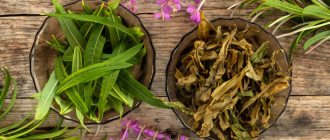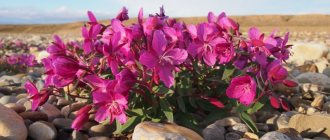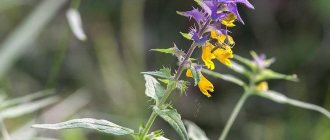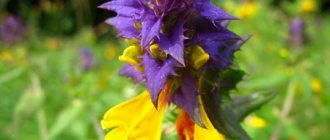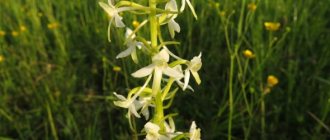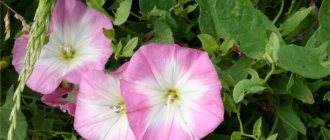Ivan tea is one of the unpretentious plants that can be found in clearings, forest edges, river banks and many other places. In the photo of the plant you can see how beautifully this amazing plant blooms. However, in addition to its visual attractiveness, Ivan tea has unusually beneficial properties for the body. Our ancestors noticed its medicinal properties. However, in modern folk medicine the plant has not lost its popularity and is successfully used to treat various diseases.
What does the plant look like and where does Ivan-tea grow? Externally, Ivan tea has light green oblong leaves and beautiful purple inflorescences. Unusual flowers can be easily seen in the photo of the plant. After the flowers fade, fluffy boxes form in their place, in which the seeds of Ivan tea ripen. Common places where grass can be found are forest clearings, meadows, river banks and waste sites.
This plant is also popularly called “fireman”. Ivan-tea received this nickname due to the fact that the plant is the first to appear in areas after a fire. Also, many call it “fire grass.” Due to the plant's belonging to the fireweed family, the herb is also called "fireweed".
Plant composition
Ivan tea has an incredibly rich biochemical composition. The presence of many useful substances ensures its benefits and effectiveness for the treatment of various ailments. So, fireweed includes the following components:
- vitamins;
- vitamin A analogues - carotenoids;
- pectin;
- useful acids;
- flavonoids;
- tannins;
- alkaloids.
A description of the plant would not be complete without mentioning the presence of polysaccharides and phytosterols and a huge variety of vitamins and microelements that are extremely beneficial for the human body. The plant contains zinc, potassium, boron, nickel, calcium and many other substances.
Ivan tea contains an extremely large amount of ascorbic acid. Here it is 5-6 times more than in lemons and oranges.
Fireweed has enormous beneficial properties for the human body. Tea not only has a beneficial effect on all human systems and organs, but also has an incredible taste. Today, the varieties of Ivan tea are very wide. It can be found both in its pure form and with the addition of various other useful plants. So, what are the benefits of tea for the body?
- Regular consumption of tea has a positive effect on a person’s immunity and overall well-being.
- With this drink you can get rid of harmful substances such as waste and toxins. The components of the plant have powerful antioxidant properties.
- For anemia, Ivan tea is also indispensable. The drink significantly improves blood composition and increases hemoglobin.
- Drinking tea allows you to normalize all metabolic processes in the body.
- Fireweed also has a positive effect on the organs of the endocrine system.
For colds, drinking tea has anti-inflammatory, antiviral and antiseptic effects. Tea is indispensable for both the treatment and prevention of flu and colds. The properties of Ivan tea also include:
- Fireweed has a beneficial effect on the psycho-emotional state of a person. Drinking the drink helps relieve stress, calm down, get rid of worries, and normalize sleep.
- Tea is also extremely beneficial for the digestive system. It has diuretic, choleretic properties, eliminates inflammatory processes of the stomach and other gastrointestinal tract organs.
- When the temperature rises, you can take slightly warm tea; the drink helps relieve fever and saturate the body with healthy vitamins.
- Fireweed works great for various types of pain. For headaches, toothaches or any other pain, it is recommended to drink the product warm 3-4 times a day.
- For sore throat, tonsillitis and various colds, it is recommended to gargle with a decoction of the plant 3-4 times a day.
Plant collection
When to collect Ivan tea? To independently prepare medicinal raw materials, the plant is picked during its flowering period. To do this, flowers and grass leaves are cut. It is recommended to leave the roots in the ground. You can collect flowers and leaves separately. It is also worth noting that if the plant is not collected during its flowering period, it will not have beneficial properties.
The plant is dried in several ways. In the first case, flowers and leaves are laid out in a well-ventilated area on paper napkins or regular newspaper. After drying, the raw materials are crushed and stored in bags made of natural fabric.
The second method is more complicated. To do this, the grass is lightly dried for 10-12 hours, then rolled into thin tubes and placed in a bowl, covered with a wet cloth. The plant is left in this form for a few more hours. The final step is to dry the leaves in a slightly preheated oven. Afterwards, the raw materials are stored in bags or paper bags. It is not recommended to store the plant in glass or tin.
There are plants similar to Ivan tea (see photo). When harvesting herbs, it is important not to confuse them with real fireweed.
External use
As mentioned above, fireweed is a plant from which a drink can heal literally anything. And its actions are multiplied when a collection is made with other herbs and flowers. By the way, like fireweed, nettle roots perfectly strengthen hair roots. After washing your hair, trichologists recommend rinsing off shampoo with it. After some time, the hair stops falling out, acquires shine and does not become frizzy.
Plantain juice, familiar to everyone since ancient times, is an excellent bactericidal agent..
How to brew tea?
The recipe for brewing fireweed is quite simple, but it is still different from preparing regular tea. So the procedure is as follows:
- You can prepare tea in both glass and ceramic containers. During the brewing process, you can feel the incredibly pleasant aroma of the drink and its stunning color.
- Herb at the rate of 2 tablespoons per 500 ml. water is poured with boiling water and left to brew under a closed lid for 10-15 minutes. The drink is considered ready when the leaves completely settle to the bottom.
- The water for preparing the drink must be of high quality, without the addition of various impurities. Various additives can affect the taste of the drink.
- Before pouring the tea into cups, the contents of the teapot should be stirred again.
You can also brew tea in a thermos. This method will allow you to experience the taste of the plant even more strongly. To do this, place 2 or 4 tablespoons of herbs in a thermos with a volume of 0.5 or 1 liter and fill it with boiling water. The lid of the thermos should be tightly sealed and the drink should be left to brew for 2-3 hours. You can drink tea with sugar or chalk to taste.
Drying
The best way to dry tea is definitely in a Russian oven. Can be dried in the sun, in the oven or in a vegetable dehydrator.
Before drying, hand-rolled “sausages” should be cut into circles 0.5 cm thick.
Oven drying
Preheat the oven to 1000 C. Cover the baking sheets with parchment paper and scatter the raw materials on it in a thin layer. The height of the layer should not exceed 1 cm. Spread the foliage of Ivan tea in an even layer, without lumps, over the surface.
Place the baking sheets in the oven, leaving the door ajar. Leave the tea to dry for 2 hours. From time to time, the leaves need to be stirred so that they dry evenly.
Properly dried tea leaves should not be soft, they should break well and look like the varieties of loose leaf teas we are used to.
Properly dried Ivan tea does not have a strong odor. The aroma and taste are revealed when they are brewed.
A few minutes before the end of drying the tea, you can slightly increase the temperature. Then the tea will brown like coffee beans, which will give the tea taste additional piquancy and depth.
Drying in an electric dryer
This option is the easiest and fastest. The only downside is that there is not enough space in the dryer. To dry a large volume of tea, you will have to lay the leaves several times.
Place a thin layer of Ivan tea leaves on the dryer trays. Set the drying mode to “herb drying” or set to a temperature of 50-700 C. Drying time is 30 minutes. Periodically you need to check the condition of the tea leaves so as not to dry out the tea.
Air drying
This method is the longest and most labor-intensive, but allows you to preserve the valuable substances in the brew as much as possible.
Drying raw materials in the open sun is not permissible.
Spread the leaves evenly over the surface in a thin layer and leave to dry for several days. The tea needs to be stirred to dry evenly. It is worth taking care to protect the foliage from insects and birds so that they do not clog or spoil the tea.
Traditional medicine recipes
In addition to brewing as tea, fireweed is also used in some traditional medicine recipes. The following methods are popular.
Treatment of the digestive system
To prevent and treat diseases of the digestive system, it is recommended to prepare a concentrated infusion from the leaves and flowers of the plant. To do this, pour a tablespoon of herbs into a glass of boiling water and cover with a lid. Infusion time is 20-30 minutes. Take half a glass in the morning and evening.
Healing remedy for burns and wounds
To prepare the medicine, place a tablespoon in an enamel container. l. plants and fill it with 500 ml of cold water. Bring the mixture to a boil over low heat and cook for another 15-20 minutes. After cooling, the decoction is used for rubbing and bathing.
Cure for psoriasis and other skin problems
Fireweed leaves (2 tbsp.) must be ground into powder and mixed with one tsp. Vaseline. The ingredients should be thoroughly mixed and added to 10 drops of sea buckthorn oil. The resulting ointment is applied to the affected areas several times a day for 20-30 minutes.
Contraindications
In some cases, the use of Ivan tea and medicines based on it is strictly prohibited. Contraindications include:
- Pregnancy and lactation period.
- Children under 6 years old.
- People with personal intolerance to plant components.
- Patients with high stomach acidity.
Before drinking tea, it is very important to consult a specialist. This will help eliminate many complications and side effects.
Ivan tea can be called a real gift from nature, because a healing drink that improves health is prepared from this plant, which is also called fireweed.
Ivan tea grows in all regions of our country. In this case, the plant does not grow alone, but forms quite extensive thickets in the form of a flower carpet.
To make healthy tea from fireweed, you should know in advance what this perennial looks like. And since the collection is carried out during the flowering period, it is especially important to be able to recognize fireweed flowers.
Height
This herbaceous plant can reach two meters, but most often in nature there are specimens of fireweed with a height of 0.5 to 1.5 meters. Ivan tea has a rather thick rhizome with a dense brown-yellow skin. Buds quickly appear on it, so the plant is propagated by parts of the root planted in the garden plot.
Stem
Ivan tea is straight, it has a rounded shape and is densely covered with leaves that have short petioles. The leaves of this plant are long - from 4 to 12 cm in length. Their shape is lanceolate and the ends are pointed. The edges of the leaves can be either whole or with small teeth. The color of the leaves above is dark green, and their lower surface is often bluish-green, although reddish and pink (less often) shades are also found.
Flowers
Ivan tea has a diameter of approximately 3 centimeters. Their color is lilac-red or pale pink, although there are also plants with white flowers. These large flowers are collected in inflorescences-brushes, the length of which reaches up to 40 centimeters. Fireweed begins to bloom in the second half of summer. Flowering lasts about a month.
Fireweed (lat. Epilobium) is a tall perennial herb or subshrub of the fireweed family (onagraceae). The plant has a straight stem reaching a height of up to 1.5 m
. The leaves are large, sessile with a pointed top, the flowers are dark pink. The fruit is a capsule. The peculiarity of the fireweed plant is a crest with fluffs, with the help of which the plant spreads. Fireweed begins to bloom in summer, from June to August.
Medicinal properties of fermented fireweed tea and contraindications
Koporye tea is not only healthy, but also very tasty and aromatic. It restores strength and gives vigor. In hot summers it quenches thirst, regardless of the form in which it is consumed - cold or hot. Regular consumption of tea increases hemoglobin and normalizes the acid-base balance. The decoction is similar in its sedative properties to mint and lemon balm tea. It normalizes the nervous system, has an anti-inflammatory and diaphoretic effect. For prevention and treatment, fireweed drink is used for the following diseases:
- Hypertension.
- Anemia.
- Prostatitis and adenoma.
- Gastrointestinal diseases.
- Infertility.
- Skin diseases.
- Vitamin deficiency and weakness of the body.
- Cough of various origins, as it has an expectorant effect.
Cancer patients are recommended to drink the drink to restore immunity and increase vitality after chemotherapy. Although fireweed is recommended for many diseases, we should not forget about contraindications. Before taking the herb, you should consult a physician.
Due to the caffeine content, caution is recommended for pregnant and breastfeeding women. The drink should also not be offered to children under 12 years of age. People with allergic reactions should also take tea in minimal quantities and after consultation with a specialist. In order for Koporye tea to bring benefits and not harm to the body, it is taken in courses. After 3 weeks of taking it, take a break so as not to provoke gastrointestinal dysfunction.
An already brewed drink can be stored in the refrigerator for up to 3-4 days, while remaining tasty and healthy
Application
The plant contains a large number of substances useful to the human body: flavonoids, ascorbic acid, tannins, starch, sucrose, essential oils, tannin. Fireweed has a wound-healing, anti-inflammatory, sedative, enveloping, hemostatic effect. In addition, fireweed acts as a laxative.
For treatment purposes, not only the leaves and inflorescences are used, but also the roots of the plant. It is recommended to use infusion and decoction of fireweed for nervous disorders
: for stress, insomnia, headaches. Due to its enveloping effect, the herb is used to treat the gastrointestinal tract (gastritis, ulcers, dysbacteriosis). Fireweed is effective for anemia, heavy bleeding, and also in the postpartum period. It is known that the plant improves metabolism, increases immunity and cleanses the body of toxins. To keep the body in good shape, the plant is brewed and drunk throughout the day as tea. It has an amber color and a pear flavor.
Ivan - tea (lat.Chamerion) is a perennial plant, belongs to the fireweed family (onagraceae). The most common type is Ivan-tea angustifolia.
(lat.Chamérion angustif%u0F3lium), popularly it is called “fireweed”, “Koporo tea”, abroad it is known as “Russian”, “heroic” tea. This drink is considered a traditional Russian herbal drink. The plant got its name from the village of Koporye, located near St. Petersburg. It grows in clearings, edges, clearings, and grows in empty places.
Ivan-tea angustifolia
Koporye tea has a calming effect on the entire body
, reduces excitability. Even in Ancient Rus', healers knew about its antibacterial effect and treated many diseases with it. The herb treats diseases of the oral cavity (tonsillitis, gingivitis, stomatitis), and the genitourinary system (cystitis, chronic prostatitis, prostate adenoma). The Ivan tea plant contains a large amount of vitamin C, its content even exceeds that of citrus fruits. The herb is taken not only internally, but also externally on wounds in the form of lotions and dressings.
The herb contains substances such as caffeine, uric acid, oxalic and puric acids. Herbal tea is not addictive. Ivan - tea is not contraindicated for pregnant and lactating women, as it has no side effects, but you should consult a doctor before use. Young leaves can be eaten.
Why is Fireweed called Ivan - tea? There is a legend about a young man whose name was Ivan and who always wore a bright crimson shirt. When he walked in the field, people said: “Tea, Ivan is walking.” Somehow the guy disappeared and was never seen again, only when the fireweed bloomed in the meadows did people in the villages remember Ivan. Since then, fireweed has been popularly called Ivan - tea.
In fact, Ivan - tea and fireweed - are one plant
, they differ only in the variety of representatives of the fireweed family. For example, marsh fireweed is found in damp places and has small dark purple flowers. Its therapeutic effect differs from Ivan tea. Another representatives of wild fireweed and wild fireweed are not used for medicinal purposes. They are distinguished from Ivan tea by external features: the stem reaches a height of up to 15 cm, and the flowers are dark purple.
What diseases are treated with medicinal herbs?
The list of diseases for which decoctions of herbs and flowers are necessary:
- Anemia, including chronic;
- Lack of vitamin C in the body;
- Weakened immunity;
- Peptic ulcer of the stomach and duodenum;
- Chronic fatigue syndrome;
- Diseases of the respiratory system;
- Diseases of the genitourinary system;
- Prostatitis and impotence;
- Thyroid gland dysfunction;
- Diseases of the central nervous system;
- Alcohol poisoning and poisoning;
- Dermatological diseases.
You may also be interested in: The benefits and harms of green tea
In case of cancer and chemotherapy, the patient is required to drink fireweed infusion.
Contraindications
Fireweed is contraindicated for people with high blood pressure, children under 5 years of age and those with individual intolerance.
Collection and drying. How to make healthy tea.
The leaves of the plant are collected during the flowering period in mid-June, in dry weather and preferably in the morning. There are two ways to collect leaves:
The stem is cut off and the leaves are torn off. The stem is held between the fingers and passed with the hand from top to bottom.
After washing, the grass is dried in a dry place on paper or thick cloth for no more than a day.
.
After drying, the leaves must undergo fermentation, that is, produce cell sap. Fermentation promotes a rich and floral flavor. This is done like this: the withering leaves are rolled into tubes with the palms to release the juice, then they are laid out in an enamel bowl and covered with a damp cloth. Keep warm for 8-20 hours
, at a temperature not higher than 25-27°C.
The final stage is oven drying.
. First, the leaves are finely chopped with scissors. Dry in the oven at a temperature of 50-60°C for 1-2 hours with the door open. The finished leaves resemble a mixture of green and black tea. Store in iron or glass containers. To improve the taste, it is necessary to stand for a couple of weeks.
Rules for preparing herbs for tea
The process of preparing tea raw materials includes several stages: collection, withering of the leaf mass, rolling of the leaves, fermentation, drying of tea.
You can do everything manually to avoid oxidation processes as much as possible and preserve all the energy in the grass. When a large volume of grass is harvested, it is difficult to do without the help of technology. A meat grinder or a special grinder will help you here.
To obtain high-quality tea with the maximum content of healing substances, its creation must be approached carefully, taking into account the rules that have been worked out over centuries.
Let us study in detail the stages of creating healing raw materials from Ivan tea.
Grass collection
- The procurement of raw materials is carried out with the beginning of flowering of Ivan tea. From the second half of July until the end of August. The best time is the end of July.
- You need to choose a place to collect grass away from the city. Leaves should not be collected along roads, cemeteries or landfills.
- It is recommended to collect in dry weather, in the morning, after the dew has dried. Raw materials collected after rain or with dew will not be stored for long.
- It is preferable to choose a slightly shaded place (near the forest, on the edges), the concentration of nutrients in such plants is higher, and the fermentation process will proceed better.
- Choose plants that have just begun to bloom.
- The best leaves are in the middle part of the plant. The lower ones are rough and can be dried out or damaged by insects. It is simply necessary to leave some of the leaves so that the plant does not die.
- Do not collect dry, insect-damaged leaves. There should be no aphids or spider mites on their surface.
- Collect leaves carefully, without damaging the plant.
- You can collect blooming flowers in a separate container. They can be added to dried leaves when brewing tea and will add a floral aroma to the drink.
- To quickly collect foliage, sweep the stem from top to bottom in one motion. And you have an armful of leaves in your hand!
The volume of feedstock as a result of the following stages will decrease significantly. A bucket of raw mass will yield 150-200 grams of dry tea.
After collecting the raw materials, you can proceed to the next stage.
Withering
At this stage the foliage should wilt (wither). The process will take approximately 24 hours. It is necessary to dry the raw materials in a ventilated area. You should strictly avoid exposing the grass to sunlight. The leaves should wilt and not dry out.
Having spread a clean, dry cloth or paper, lay the foliage on the surface evenly, in a layer of no more than 5 cm. When laying out, you should immediately remove dirty or damaged leaves, debris, parts of other plants and insects. Washing the foliage is unacceptable.
To understand whether the raw material is ready for the next stage, you need to bend the sheet. When you press on the leaf, the central vein should not crack. Otherwise, you need to leave the tea to dry some more. In wet weather it takes longer to wilt.
Twisting
After the raw materials have successfully withered, we proceed to the next stage. All foliage must be rubbed between your palms, twisting “sausages” 5-10 cm long. You can roll the foliage on a cutting board. You need to twist until the juice comes out of the leaves. During the grinding process, the intercellular partitions are destroyed, the juice flows out and mixes. When you notice that the “sausage” has darkened, you should put it aside and start rolling the next one.
With a large volume of foliage, this process is labor-intensive. To simplify and speed up the process, you can twist the foliage through a meat grinder
.
Another way is to crush the leaves with a rolling pin until dark on an oak table. You can lay the foliage on a clean cloth, roll it up and crush it in several hands.
Hand rolling results in loose leaf tea. This is how real Koporye tea is made. When using a meat grinder, the tea will turn out granular. The meat grinder can be manual or electric. It is recommended to use a large mesh so that the raw materials do not clog the meat grinder. Dried leaves should be placed in a meat grinder in parts.
When the leaves are passed through a meat grinder, more juice is released than when twisted by hand. Rolling initiates the next step in producing tea – fermentation.
Fermentation
In order for the tea to brew well and give maximum taste and aroma, the raw materials must undergo a fermentation process (natural fermentation) after withering. The final taste and aroma of tea depends on the time and temperature during fermentation. This stage is very important, because it is now that tea acquires its taste, color, smell and aroma.
You can make green, yellow or black tea from Ivan tea. Now you need to decide whether the brew will be loose or in briquettes.
How fermentation time affects the taste of tea:
| Fermentation degree | Fermentation time | Taste and aroma |
| Light | 3-6 hours | A fruity-floral smell appears. The taste is delicate, soft. The aroma is strong. |
| Average | 10-16 hours | The aroma is bright. The taste is tart, with a slight sourness. |
| Deep | 20-36 hours | The smell is strong. The taste is strong with a light aroma. |
During fermentation, it is preferable to under-exert the tea a little rather than over-exert it. Raw materials may ferment or become moldy.
A simple fermentation method
Place leaves in glass, plastic or ceramic containers and fill with water. If twisting was done manually, cover the top of the foliage with a damp cloth and place a weight on top for several hours. The load will create pressure on the foliage.
If the foliage was deboned mechanically, the raw materials should be compacted in a container more tightly and covered with a damp cloth. Place the containers in a warm place or in a sunny place for 24-36 hours. During this time, the raw material should become soft. Initially, the herbal smell should change to a fruity, sweetish one during the fermentation process.
After the fermentation process is complete, remove the mass from the containers, loosen and dry.
When collecting leaves late (at the end of August), repeat the fermentation process 2 times, crushing the leaves in your palms (or passing them through a meat grinder without knives) until the juice is released between the two stages.
Fermentation under pressure in its own juice
Divide the collected foliage into 2 parts. Pass one part through a juicer or meat grinder and squeeze out the juice.
Place the second part of the leaves in a ceramic, plastic or glass container and fill with juice. Place a lid of a smaller diameter on top and press down with a weight. The weight of the oppression must be at least 20 kg. If the load is metal, it must first be placed in a bag so that the metal does not come into contact with the “brine”.
The fermentation process lasts 3 days. Upon completion, the raw materials must be dried.
Brewing rules
To make tea fragrant and tasty, you need to prepare it correctly. To begin with, pour boiling water over the kettle several times, add 2-3 teaspoons of tea and add boiled water. Let it brew for 10-15 minutes and you can enjoy the drink. Tea can be brewed several times without losing its beneficial properties.
Fireweed hairy
Hairy fireweed is the largest and most visible representative of the genus Fireweed. Description and photo of fireweed, its differences from fireweed
Hello dear reader!
The name of the plant “fireweed” is strongly associated with fireweed. Although from a biological point of view this is not true. Botanists have long ago separated fireweed into a separate genus with the same name (Chamerion in Latin).
Most of our fireweeds are significantly inferior to narrow-leaved willowherb both in size and, especially, in the size of flowers. I have already written about rose fireweed. And there are also marsh fireweed, small-flowered fireweed, mountain fireweed and others.
The most similar to fireweed is fireweed. It is not inferior in size, sometimes reaching the height of a man, and its flowers are the largest among the representatives of the Cyprus genus. But fireweed and fireweed have many important differences.
Shoots of hairy fireweed grow up to 1.5 meters
Hairy fireweed: description, photo. Differences from fireweed
Hairy fireweed grows on excessively moist soils: along the banks of rivers, lakes, streams, in damp meadows, ditches. In the forest it can be found in damp clearings and forest roads. It can also be a weed - it grows in waterlogged areas of fields and vegetable gardens.
Ivan-tea angustifolia, quite indifferent to soil conditions, can be found in the same places, even nearby. But on dry sandy soils, which are very popular with fireweed, hairy willowherb will not live.
Blooming fireweed
Hairy fireweed (Epilobium hirsutum) is a rhizomatous perennial, a European species characteristic of countries with temperate climates. It was accidentally introduced by humans to North America and Australia, where it poses a serious environmental problem, displacing native plant species. In Russia, hairy willowherb is common in the forest belt of the European part, in Western Siberia.
The stem of this fireweed is highly branched. In height, the plant can reach almost human height. In this case, the thickness of the stem reaches almost a centimeter.
On the stem, peduncles, leaves, and fruits, pubescence is noticeable, which is why hairy fireweed got its name. True, you can detect “hairiness” only by looking closely. There are long hairs, but thin and soft, and there are also short, glandular ones.
Hairy willowherb has noticeable pubescence on the stems and leaves
I would say that the “shaggyness” of the hairy fireweed is manifested only in comparison with other representatives of the genus, in which it is not so pronounced.
This is the difference from Ivan tea. It doesn't have any hairs on its stem.
The leaves of the fireweed are lanceolate and arranged oppositely (except for the topmost ones - they are alternate). The edge of the leaf is finely toothed. The leaves are sessile, their base encircling the stem. Leaf blades are pubescent.
Hairy fireweed leaves
Differences: fireweed has alternate leaves; there is no pubescence; the edge of the leaf is smooth.
Hairy fireweed blooms in July – August. Its flowers are arranged singly on peduncles growing in the axils of the upper leaves.
Flowers and fruits of fireweed
Angustifolia fireweed flowers are collected in clusters at the tops of the main and side shoots. Such brushes are not observed in hairy fireweed.
The flower of the fireweed is larger than the flowers of other representatives of the genus. The diameter of the flower can reach 2 - 2.5 cm - five times larger than the pink fireweed flower.
The flower of the hairy fireweed is similar to the flowers of other fireweeds, but larger than them
The structure of the flower is the same as that of other fireweed (including fireweed) - 4 narrow sepals, 4 petals, 8 stamens and a pistil with four stigmas. The petals at the top are divided into two lobes by about a third (this is already a distinctive feature of the Cyprus genus). The color of the petals is dark pink, purple, and occasionally white.
The color and size of the flowers of hairy fireweed are similar to the flowers of fireweed. But the petals of fireweed are usually rounded at the top, not dissected. And if such a dissection does sometimes occur, then it is only intended.
In August–September, hairy fireweed bears fruit. Its fruits are long tetrahedral boxes (up to 10 cm), similar to some kind of pods, but opening with four doors. The capsules contain many small seeds equipped with off-white hairs.
There are no big differences in the structure of the fruits from fireweed.
In the soil, fireweed has a thick but short rhizome (willowherb has a long rhizome). With such a rhizome you won’t spread particularly far!
Hairy fireweed solves the problem of dispersal and vegetative propagation in a different way. At the end of summer, new, shortened shoots begin to grow from growth points located at the border of the shoot and rhizome. These shoots grow horizontally. They bear rudimentary rosettes of leaves that give rise to new plants. After new shoots take root, these formations die off. It is more correct to call them stolons.
Shoots-stolons of hairy fireweed grow by autumn
These shoots are both aboveground and underground. Aboveground shoots - stolons are reddish, underground - white.
Underground shoots-stolons are white
It is clear that fireweed does not have such formations - it does not need them, it has long horizontal rhizomes. But this method of vegetative propagation does not allow the fireweed to spread far. And the plant does not form extensive thickets like those of narrow-leaved fireweed.
What else can you add? People practically never use fireweed. Beekeepers do not consider it a good honey plant. Although bees do visit flowers, I have observed them myself. The plant is not used for medicinal purposes. It is not found in reference books on traditional medicine.
Fireweeds are not poisonous. If desired, the young leaves can probably be eaten. But nothing is known about the food use of fireweed.
But it is quite possible to use the plant to decorate artificial reservoirs. Yes, it can settle on its own on the shore of your pond!
Let's summarize. Hairy fireweed is by no means a “type of fireweed,” as is sometimes claimed. This is a separate species, even belonging to a different genus of fireweed than fireweed. You can say - here it is, real fireweed!
Best regards, Alexander Silivanov
Subscribe to news? Click on the picture!
By clicking on the picture, you consent to the newsletter, the processing of personal data and agree to the privacy policy
Multifaceted taste of Ivan tea
However, in 2013, having tried Ivan tea as a guest in the Krasnodar Territory, G. Maidantsev’s opinion changed dramatically. The tea had a surprisingly pleasant aroma, similar to a flowering meadow. And it had a special taste.
Having asked the owners why their fireweed turns out to be so tasty, he learned that the leaves are fermented, and the drink is made according to the ancient Russian tradition. The taste greatly depends on the length of fermentation.
When brewed again, the drink is just as aromatic as when brewed for the first time.
It remains bright and pleasant.
Admiring the beautiful carpet of bright red, pale pink, yellow and white wildflowers, many do not even suspect that in front of them is real fireweed. From this wonderful plant, dried and fresh, medicinal teas are brewed and medicinal tinctures are prepared for many ailments.
Now, knowing what the herb Ivan tea looks like in the photo, you can recognize it yourself during a country walk and prepare it for the whole year.
What does fireweed look like?
The scientific name of fireweed is fireweed, chamenerium or chamenerium angustifolium. There are about a hundred popular synonyms for this herb: Mother of God grass, willow grass, magpie eyes, hoof grass, Koporye tea, wild flax, wild violet, field cornflowers, field sage, sweet clover, cobbler, wheatgrass, etc.
The leaves of this plant look like long knives. Botanists call this oblong shape lanceolate (reminiscent of the shape of a medical scalpel or lancet).
The pointed, shiny leaves are finely serrated at the tips and taper towards the base. Leaf petioles are most often short. The leaves are two-colored. Their surface facing the sun is dark green, and the reverse side can be gray, purple-red, and sometimes pale pink.
Inflorescences are collected in brushes. The fruit of fireweed is a small, pubescent capsule. The seeds in it are oblong, with thin long white hairs.
When collecting fireweed, mark the place where you found it. Why? Because this plant is a perennial, and next year you will find new fireweed glades here.
Its thick, succulent rhizome resembles the creeping root of mint or elderberry. The straight, thick stem is densely covered with leaves.
On favorable soils, fireweed often reaches a height of two meters. On average, the height of its stem with inflorescences is about half a meter.
Where to look for fireweed?
Fireweed grows in dry, sandy areas of soil, in light, unshaded groves, often in clearings and fires. Therefore, the plant is sometimes also called “fireman”.
Chameneria spreads along country roads, highways, and railway embankments.
Road workers plant this plant to strengthen roadsides and slopes. But you should not collect grass in such places, because its leaves accumulate dangerous substances from the exhaust gases of car and locomotive engines.
Chamenerium blooms in June-August. Its fruits, suitable for medicinal preparations, ripen in late summer and early autumn: in the south - in August, in the north - throughout September.
Tea plantation in the garden
If you have a suburban area, then you can plant fireweed in your garden. To do this, dig up fireweed along with a lump of earth and plant it in the garden along the paths in places well lit by the sun.
From this multi-colored grass you can create wonderful flower arrangements, which landscape designers take note of.
Ivan tea is characterized by increased growth and spread activity. Therefore, think in advance about how to limit the spread of its roots.
In addition to teas, fresh young shoots and leaves can be used to prepare vitamin-rich salads. And boiled shoots can be eaten along with vegetables.
Bees love to collect fireweed nectar because it contains a lot of fructose and glucose. Honey from fireweed tea turns out to be unusually fragrant, watery-transparent in consistency, with a greenish tint.
Ivan tea, growing in natural habitats, can be found in a clearing, in a meadow, on the edge of a forest, on the bank of a river. Many people treat it as just a beautiful weed plant, but it contains a large amount of vitamins and minerals and is a medicinal plant known since ancient times. But, at the same time, there are flowers similar to fireweed, so you need to know how to distinguish them from each other so as not to harm your health during the treatment process.
Ivan tea is a well-known medicinal plant with an original appearance.
Growing and care on the site
Ivan tea can be grown in a summer cottage. This plant is famous not only for its medicinal properties, it is also visually attractive. There are two popular methods of growing fireweed.
From seeds
You can buy seeds or prepare them yourself. Collection time is early autumn, 1-2 months after the perennial blooms. The seeds must be thoroughly dried, removing fluff from them. Store in a dry, dark place.
For seedlings, seeds are sown in boxes in early spring. The seeds are very small; if they are sown immediately in the ground, they will be washed away by rain or blown by the wind. The soil for planting needs loose, light soil. Mix river sand, humus and peat in equal proportions. It is not recommended to deepen the seeds; it is better to scatter them over the surface of the soil substrate and “water” them generously from a spray bottle. Cover the box with glass or film and place in a warm place (the temperature for germination should be at least +20 degrees). The first shoots will hatch in about five days.
The seedlings dive when two true leaves appear. Planted in open ground in the first days of summer. Before planting, the seedlings are hardened off by placing them in fresh air for 3 days.
Tip: seedlings should be planted on a cloudy day (preferably in the rain). In the sun, young plants will wither and may even die.
Vegetatively
A simpler method, unlike the previous one. The perennial grows in forest clearings, along roads, and near reservoirs. You can dig up its roots and plant it on your site.
The root system of the medicinal crop is spreading, so it is better to dig it up with a lump of earth. The rhizome is placed in a shallow hole, where humus, sand and ash are first added. After planting, water thoroughly. The top of the soil is mulched with straw or dried grass.
Fireweed transplanted in this way quickly takes root in its new location.
Caring for a flower is not difficult.
The rules of care are as follows:
- the place for growing perennials must be sufficiently lit;
- Water sparingly, depending on the weather. Once a week in the evening or morning during intense heat. A plant from a meadow usually gets enough rain;
- loosen the soil after watering once a month;
- One mineral fertilizing per season is enough;
- for the winter, the stem of the fireweed is cut off, leaving a petiole 15 cm long from the soil;
- A good place for planting is near a fence or outbuilding, in which case the plant will not be damaged by the wind.
Tip: Fireweed grows very quickly. To prevent it from extending beyond the designated area, it must be fenced underground. To do this, iron sheets or slate are dug along the perimeter of the flowerbed to a depth of about 1 meter.
Ivan tea blooms in the second year no matter how it is planted. Flowering period: end of June – mid-August. The pubescent seeds ripen after flowering. To prevent the seeds from being blown across the garden plot by the wind, they must be cut off before they ripen.
Insect pests do not grow on fireweed; it also has good immunity to diseases. Ivan tea improves the condition of the soil on which it grows.
Description of fireweed
Fireweed (Epilobium angustifolium) narrow-leaved fireweed or Koporye tea is a herbaceous perennial plant belonging to the fireweed family. People also call it weeping grass, field sage, mulberry, sage and several dozen other names. It is distinguished by its unpretentiousness and attractive appearance. Its straight, smooth stems reach one and a half meters in height. The jagged, shiny, dark green foliage is lanceolate in shape. Depending on the location of growth, the lower part of the leaf may have a bluish-green, reddish-purple or pinkish tint.
Flowering fireweed begins in mid-summer. The flowers of the plant can be white, pink or lilac-purple and have a diameter of 4 to 12 centimeters. They gather in large pyramidal-racemose inflorescences at the tops of the stems.
When the flowers of fireweed are in full bloom, they are collected along with the leaves to prepare medicinal raw materials. After drying, they are used to prepare medicinal products or simply for brewing tea.
Plants similar to fireweed include, first of all, clarkia (elegant, pretty, pleasant), Californian fuchsia, Gaura biennial, and evening primrose. Despite some similarities, they also have a number of significant differences from fireweed.
Clarkia graceful or marigold (Clarkia unguiculata or Clarkia elegans Douglas) belongs to herbaceous plants of the fireweed family. Unlike fireweed, it is an annual plant that grows no higher than 90 centimeters and has oval-shaped bluish-green foliage with pronounced reddish veins and sparsely jagged edges. Its straight stems are lightly pubescent and strongly branched.
Flowering of the plant begins in June and lasts until mid-autumn. The flowers can be white, hot pink, salmon, red, purple, blue, lilac or violet and have a diameter of no more than 4 centimeters. Like fireweed, they are collected in racemose inflorescences located in the upper part of the stems. Clarkia graceful has varieties that have double flowers.
Clarkia pulchella is a herbaceous perennial that reaches no more than 60 centimeters in height. On its erect, branched stems there is a large amount of narrow, long, oval-shaped foliage. It is pointed towards the tip and slightly narrowed towards the petiole.
The flowers are lilac in color; they are not collected in inflorescences like fireweed, but are arranged singly or in groups in the axils of the foliage at the tops of the stems. Depending on the variety, they can have either a simple or terry shape.
Clarkia amoena or pleasant godetia is a small fireweed plant with a very attractive and elegant appearance. Its height does not exceed 30 centimeters. The stems are strewn with small gray-green foliage, ovate-lanceolate in shape and up to 5 centimeters long. The flowers, reminiscent of small roses, can be white, red or variegated with various spots and stripes, their diameter does not exceed 5 centimeters. There are varietal hybrids of pleasant clarkia with a simple and terry shape.
Fuchsia Californian
California fuchsia (Zauschneria), hummingbird or hummingbird flowers is a very drought-tolerant perennial of the fireweed family. As the name suggests, California is considered the plant’s homeland, where it thrives in the wild and blooms on rocky soils and rocks in extreme heat.
It is an ampelous form, and its flowers are bells of a very unusual shape and orange-red color. They have 4 large, slightly loose petals and 8 long red stamens. Some varieties have additional oddly shaped petals in the middle. The plant consists of stems that reach up to 60 centimeters in height. They have slightly pubescent leaves with a grayish-green tint.
Learn and care for the plant.
Appearance of the plant
Ivan-tea - (also known as Koporye tea, fireweed, fireweed, skrypnik, plakun) - a perennial, bush-like herbaceous plant of the fireweed family, 50 cm high. Can reach a height of up to 2 meters. The leaves are elongated, narrow, pointed, arranged alternately on an erect stem.
The flowers are light pink, sometimes white. Ivan tea blooms in summer; the flowering period differs in different regions of Russia. In the central zone of the country, flowering begins in late June-early July and lasts 30-50 days. The blossoming of the fireweed field is an incredibly beautiful sight. Reminds me of a beautiful pink sea. The blossoming flowers are fragrant with a strong honey aroma.
Fireweed can be found throughout the northern hemisphere. On the territory of Russia it predominates in non-chernozem regions. Huge fields of fireweed in Altai and the Urals. Fireweed prefers to grow in open, well-lit areas, forest edges, and in areas scorched by fire.
Koporye grass reproduces by seeds and root shoots.
The first mention of the drink from Ivan tea is found in documents from the 12th century. In the Novgorod chronicles of the 13th century, a drink made from fireweed is called a heroic drink. Koporye tea began to be called a drink made from fireweed because the monks from the settlement of Koporye were the first to prepare it.
Due to its characteristic appearance and many valuable healing properties, Ivan tea has many names among the people: willow grass - for its external similarity with the willow tree, fireman, willow-grass, willow-grass, downy grass, fur grass, drowsiness, napkin.
